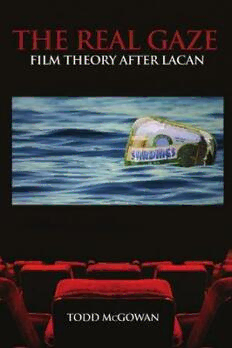
The Real Gaze: Film Theory After Lacan PDF
Preview The Real Gaze: Film Theory After Lacan
The Real Gaze SUNY series in Psychoanalysis and Culture Henry Sussman, editor The Real Gaze Film Theory after Lacan Todd McGowan State University of New York Press Published by State University of New York Press, Albany © 2007 State University of New York All rights reserved Printed in the United States of America No part of this book may be used or reproduced in any manner whatsoever without written permission. No part of this book may be stored in a retrieval system or transmitted in any form or by any means including electronic, electrostatic, magnetic tape, mechanical, photocopying, recording, or otherwise without the prior permission in writing of the publisher. For information, address State University of New York Press, 194 Washington Avenue, Suite 305, Albany, NY 12210-2384 Production by Marilyn P. Semerad Marketing by Michael Campochiaro Library of Congress Cataloging-in Publication Data McGowan, Todd. The real gaze : film theory after Lacan / Todd McGowan. p. cm. — (SUNY series in psychoanalysis and culture) Includes bibliographical references and index. ISBN-13: 978-0-7914-7039-8 (hardcover : alk. paper) 1. Film criticism. 2. Motion pictures—Philosophy. I. Title. II. Series. PN1995.M3795 2007 791.4301—dc22 2006013426 10 9 8 7 6 5 4 3 2 1 For Hilary Neroni, who embodies nothing for me Contents Preface ix Acknowledgments xi Introduction: From the Imaginary Look to the Real Gaze 1 PART1. THECINEMAOFFANTASY: EXPOSINGTHEEXCESS Chapter 1. Fantasy and Showing Too Much 23 Chapter 2. Theoretical Fantasizing 31 Chapter 3. The Politics of Cinematic Fantasy 35 Chapter 4. Early Explorations of Fantasy 39 Chapter 5. The Coldness of Kubrick 43 Chapter 6. Spike Lee’s Fantasmatic Explosions 49 Chapter 7. Michael Mann and the Ethics of Excess 57 Chapter 8. The Bankruptcy of Fantasy in Fellini 63 PART2. THECINEMAOFDESIRE: ABSENCEAMIDTHE PLENITUDEOFTHEIMAGE Chapter 9. Desire and Not Showing Enough 69 Chapter 10. Theoretical Desiring 75 Chapter 11. The Politics of Cinematic Desire 79 vii viii Contents Chapter 12. The Impossible Object of the Nouvelle Vague 83 Chapter 13. The Banality of Orson Welles 91 Chapter 14. Claire Denis and the Other’s Failure to Enjoy 99 Chapter 15. Political Desire in Italian Neorealism 107 PART3. THECINEMAOFINTEGRATION: THEMARRIAGEOF DESIREANDFANTASY Chapter 16. The Intermixing of Desire and Fantasy 115 Chapter 17. The Theoretical Opposition 123 Chapter 18. The Politics of the Cinema of Integration 127 Chapter 19. The Ordinary Cinema of Ron Howard 131 Chapter 20. Steven Spielberg’s Search for the Father 137 Chapter 21. D. W. Griffith’s Suspense 147 Chapter 22. Films That Separate 155 PART4. THECINEMAOFINTERSECTION: COLLISIONSOF DESIREANDFANTASY Chapter 23. The Separation of Desire and Fantasy 163 Chapter 24. Theorizing the Real 171 Chapter 25. The Politics of the Cinema of Intersection 175 Chapter 26. The Overlapping Worlds of Andrei Tarkovsky 179 Chapter 27. Alain Resnais between the Present and 185 the Past Chapter 28. Wim Wenders and the Ethics of Fantasizing 195 Chapter 29. The Sexual Relationship with David Lynch 203 Notes 211 Index 247 Preface FILM THEORY TODAY is almost nonexistent. The universalizing claims about the cinematic experience made by figures such as Sergei Eisenstein, André Bazin, Christian Metz, and Laura Mulvey have disappeared. Contem- porary film scholars are increasingly content to make local, particular claims about film. This focus on particularity—that is, the analysis of isolated phe- nomena—completely dominates the field of film studies. Amid this contem- porary landscape, proffering a universal and totalizing theory of the filmic experience seems outdated and naïve. The turn away from film theory coincides with a turn away from film itself. Those working in film studies tend to understand film by contextualiz- ing both the filmic text and the experience of spectatorship. Janet Staiger gives expression to this prevailing view when she claims, “I believe that contextual factors, more than textual ones, account for the experiences that spectators have watching films and television and for the uses to which those experiences are put in navigating our everyday lives. These contextual factors are social formations and constructed identities of the self in relation to historical condi- tions.”1By focusing so intently on the context of film production and recep- tion, we lose the possibility of being able to see the way in which an aesthetic object like a film might not fit within the context where it appears. Though every film emerges from within a context, not every film completely obeys the restrictions that the context places on it. Films can, in short, challenge their context through their individual mode of aestheticizing it. Or, to put it in Eric Santner’s words, miracles do happen.2And even those films that end up reca- pitulating their context cannot be immediately reduced to it. A layer of medi- ation exists even in these cases: a completely conformist film must first alienate itself from its context in order to find the form to uphold it. ix
